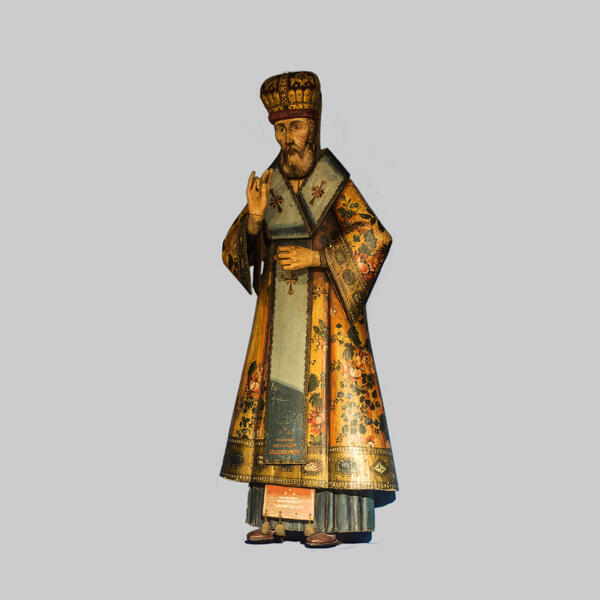Nicholas the Wonderworker is one of the most revered saints in Russia. He was often depicted on icons, and had many churches named after him. Legends say that he performed his numerous miracles during his lifetime. In their prayers, people ask Nicholas the Wonderworker for intercession before God, for the release of prisoners, to avert the punishment of the innocent and slandered, or to keep their children safe and healthy. They also ask for his help in everyday matters, like finding lost things, getting married, overcoming an illness, or finding a job. The Akathist to Saint Nicholas, the Canon, and other prayers have been compiled to glorify the saint.
The first wooden church in ChelyAbinsk was named after Saint Nicholas. When the stone Nativity Cathedral was built in 1766, one of its side chapels was consecrated as Nikolsky (literally: St. Nicholas). The side chapel contained a sculpture of Nicholas the Wonderworker. In his ‘Urals Travel Guide’ written at the beginning of the 20th century, journalist and ethnographer Viktor Aleksandrovich Vesnovsky wrote, ‘One of the church’s side chapels contains a life-size figure of Saint Nicholas the Wonderworker in full vestments.’
The sculptor depicted the saint in the ceremonial vestments of a bishop decorated with floral ornaments. The painting on the robe also imitated pearl embroidery and gemstone inlays. The headdress (miter /ˈmī-tər/) was decorated with copper stars and pieces of amethyst and rock crystal. ChErub faces were also depicted on it. The saint’s right hand is raised in a blessing gesture.
Wooden sculptures are rarely found in Orthodox churches. They belonged to the ‘Folk Orthodoxy’ phenomenon and were persecuted by the church authorities in the 18th and 19th centuries. In 1722, the Holy SynOd (a church governing body) issued a decree demanding the removal of wooden sculptures from Orthodox churches. A similar order was later issued in 1832. Despite this, the people of Chelyabinsk preserved the revered statue. It also survived the Soviet era. After the destruction of the Nativity Cathedral in 1932, the sculpture was transferred to the museum and added to its collection.
Since 2006, the sculpture of Saint Nicholas the Wonderworker has been part of the museum’s exhibit dedicated to the history of Orthodoxy in the Southern Urals.
The first wooden church in ChelyAbinsk was named after Saint Nicholas. When the stone Nativity Cathedral was built in 1766, one of its side chapels was consecrated as Nikolsky (literally: St. Nicholas). The side chapel contained a sculpture of Nicholas the Wonderworker. In his ‘Urals Travel Guide’ written at the beginning of the 20th century, journalist and ethnographer Viktor Aleksandrovich Vesnovsky wrote, ‘One of the church’s side chapels contains a life-size figure of Saint Nicholas the Wonderworker in full vestments.’
The sculptor depicted the saint in the ceremonial vestments of a bishop decorated with floral ornaments. The painting on the robe also imitated pearl embroidery and gemstone inlays. The headdress (miter /ˈmī-tər/) was decorated with copper stars and pieces of amethyst and rock crystal. ChErub faces were also depicted on it. The saint’s right hand is raised in a blessing gesture.
Wooden sculptures are rarely found in Orthodox churches. They belonged to the ‘Folk Orthodoxy’ phenomenon and were persecuted by the church authorities in the 18th and 19th centuries. In 1722, the Holy SynOd (a church governing body) issued a decree demanding the removal of wooden sculptures from Orthodox churches. A similar order was later issued in 1832. Despite this, the people of Chelyabinsk preserved the revered statue. It also survived the Soviet era. After the destruction of the Nativity Cathedral in 1932, the sculpture was transferred to the museum and added to its collection.
Since 2006, the sculpture of Saint Nicholas the Wonderworker has been part of the museum’s exhibit dedicated to the history of Orthodoxy in the Southern Urals.



